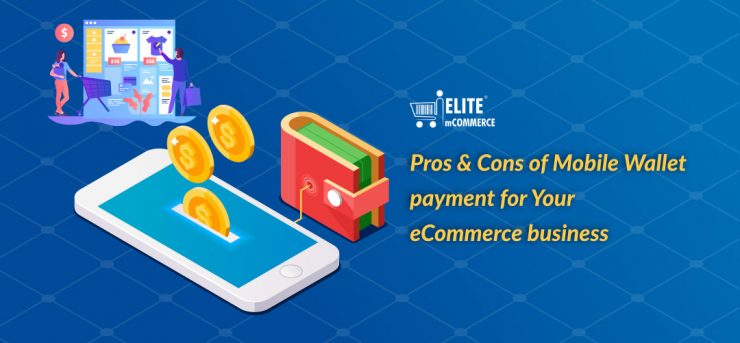Now that digital wallets are widely supported by the mobile devices we carry everywhere, many are urging eCommerce stores to accept them as a payment method more widely. For stores that are already offering a wide variety of payment options, only to see new mobile payment technologies gaining popularity, is it worth it to adopt mobile wallets? Any payment method can mean additional sales from customers who prefer that method, but e-wallets may have downsides as well.
The Rise of Mobile Wallet Payments
Most consumers have easy access to mobile wallets, even if they don’t use them yet. Apple Pay is now supported by 93 per cent of all iPhones in the United States, while Samsung Pay is bundled with many of the most popular Android devices. As of last September, Apple Pay has 441 million users worldwide.
Mobile wallets or e-wallets let consumers transfer cash electronically without using a credit card, letting them load their card details into an app and pay physical transactions at point-of-sale terminals from their mobile devices using NFC connections. They are also supported as a payment option when paying for online transactions by many sellers through logging in and authorizing the app. As a contactless payment method, they offer a more friction-free checkout that doesn’t require is safer in the current time of the pandemic, and use tokenization to avoid sharing payment information insecurely during transactions.
The Role of Digital Wallets in Online Transactions
A survey from Ad Colony found that 56% of consumers plan to use smartphones to do their online shopping, and 45% of consumers use their smartphone to shop all the time. Mobile eCommerce apps are beginning to dominate online sales, making it critical for eCommerce platforms to capture the attention of mobile users. When increasing the mobile-friendliness of the store browsing experience, it makes sense to consider adding a button at checkout for popular mobile-based payment options.
Read more :- Announcing Happy Hours Notifications for Your Grocery App
The convenience of being able to use the same payment method for physical and online transactions can be a powerful incentive for customers to use their mobile wallet for online purchases. Digital wallets are also popular among people without consistent access to active bank accounts, one of the factors that have led to their widespread adoption in developing countries. In response to the growth of a customer base that prefers mobile wallets to other payment methods, it’s essential for eCommerce to be able to reach them.
Mobile wallets can play a major role in reducing the number of abandoned carts at checkout. Many customers are discouraged by inconvenient checkout processes, especially when they require creating an account and/or entering credit card information. Baymard Institute found an average cart abandonment rate of 69.57%, and reasons given by surveyed consumers included 28% not wanting to make an account, 21% finding the process too complicated, 17% not wanting to give credit card information, and 6% finding the payment options lacking. All of these issues could be resolved more easily by sites that support digital wallet payments. Mobile users are able to pay faster and without needing to enter additional payment information.
Disadvantages of Mobile Wallets
While mobile wallets have a number of advantages for both in-person and online transactions, businesses should be wary of potential downsides. Most notably, the adoption rate in the US has not been as high as anticipated, even though demand for contactless payment was expected to rise during the pandemic. According to a report from PYMNTS from April, Apple Pay’s usage has dropped from 6.7% in 2017 to 5.1%, and Walmart Pay went from 4.5 per cent to 3.3 per cent from 2019.
Many customers in the US are not looking to adopt a new payment method or don’t see it as more secure, and if adoption rates do not rise, many retailers have less reason to accept mobile wallet payments.
While the tokenization process secures transactions, it limits the ability of retailers to gather data on the payee. Payments consultant Deborah Waxley told Digiday that this “impedes efforts to market and promote offers using customer data.”
Finally, vendors should be aware of the transaction fees for processing digital payments, which can be 2-3% of the transaction. These are not too different from existing credit card fees, but it’s worth reviewing if a particular digital wallet’s fees are significantly higher than alternatives. While their current usage is low in the US, digital wallets have the potential to simplify both in-person and online transactions, and online platforms can benefit from being flexible with payment options if it provides a smoother checkout process.









In the era of IT, everyone needs comfort this is happening more while you are paying for something. In this, you explain the Digital Wallet and its advantage and disadvantage in the e-commerce business and its mobile wallet transaction fees.
Thanks for sharing this article, It’s very helpful for me to understand the mobile wallet and its benefits.
Many people are asking eCommerce companies to adopt digital wallets as a payment option more broadly now that they are widely supported by the mobile devices we carry everywhere.
An e-wallet application helps people or end-users to manage their income and expenses easily, it is a multi-purpose app that can help you carry out monetary transactions and manage finances.
Well Explained about the pros & cons of Mobile Wallet payment, thank you. An E-wallet app simplifies payments for your eCommerce business with secure and convenient eWallet options.